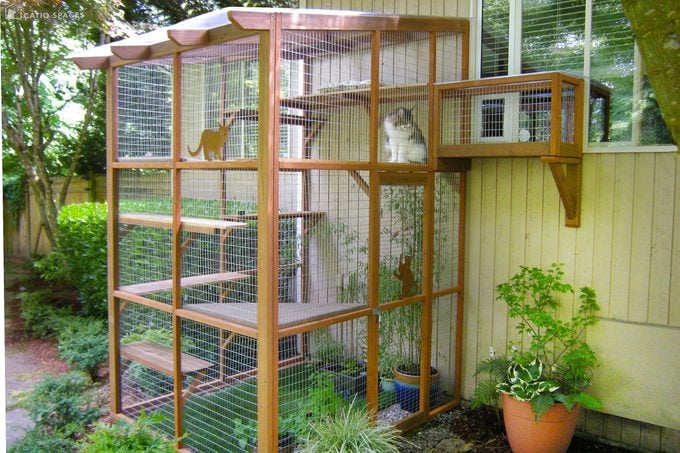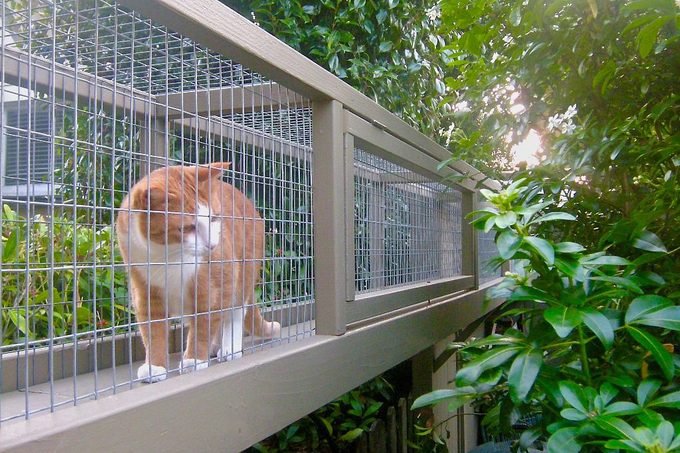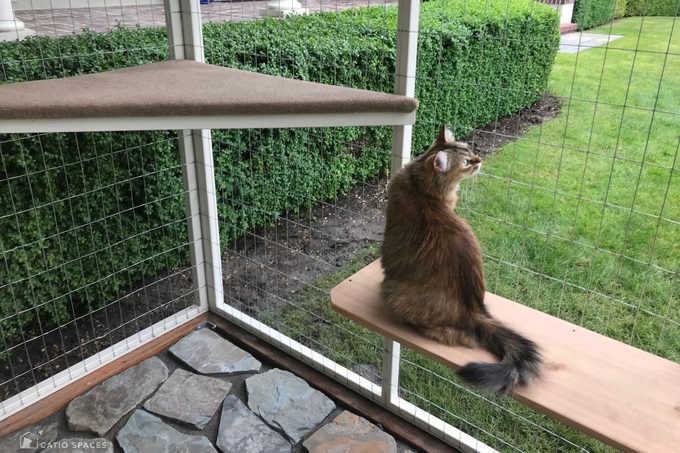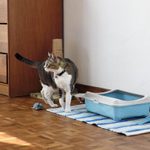What’s a Catio and Why Would I Want One?
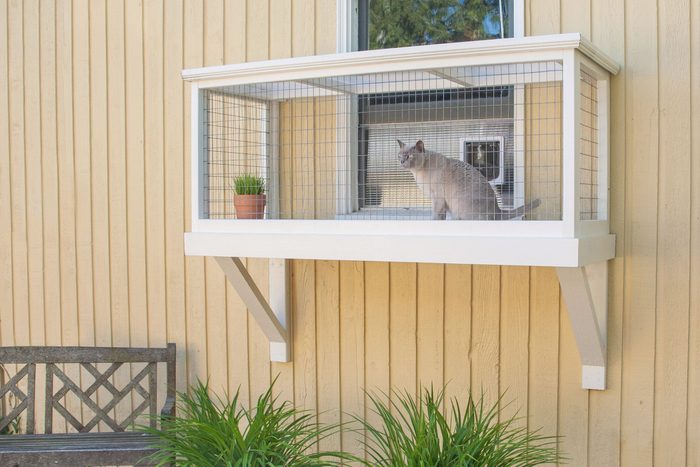
The catio revolution is afoot. Here's what to know about cat patios, which keep kitties and wildlife safe.
Our editors and experts handpick every product we feature. We may earn a commission from your purchases.
I first heard the word catio from my friend who’s a park ranger. She witnesses firsthand the damage outdoor domestic cats do to ecosystems and endangered species, and sees catios — outside enclosures for cats — as the solution.
Cats are the No. 1 threat to birds in the U.S., killing an estimated 2.4 billion every year. That’s 20 percent of the total bird population. Domestic cats allowed to roam outside also kill millions of small mammals, reptiles and amphibians.
“Cats are cute to us, but from the perspective of local wildlife, they’re huge apex predators,” says Liz Baessler, senior editor at Gardening Know How.
“That’s why more and more people are opting to install a catio that lets your cat experience the sights, sounds and sensations of being outdoors, all while keeping their would-be prey at a safe distance. It also protects your cat from the dangers of the wide world, from cars to rival cats to the occasional even bigger predator.”
Here’s more about why you might want a catio, and how to make or buying one.
On This Page
What Is a Catio?
A catio, aka cat patio, is an enclosed structure that lets cats hang out in a safe outdoor environment. Walls are usually mesh or wire, and they often include a cat door. They range from small window boxes to large, complex patios.
Types of Catios
Catios come in many shapes and sizes, from simple wire-mesh boxes to elaborate multi-level playgrounds. They can be DIY, built from a kit or custom constructed by professional catio makers.
“The options for catios are endless,” says Cynthia Chomos, catio designer and founder of Catio Spaces. “If you only have a small area to work with, keep in mind cats love high spaces, and you can add lots of shelves for vertical and horizontal movement in a catio.”
You can also add tunnels around the yard at various elevations for further cat exploration.
Stand-alone catios
Freestanding catios are not attached to the home, so they can be placed anywhere in your yard or garden. One drawback: “Kitty guardians must take their felines and put them in and take them out,” says Yvette Bacha of Hellas Custom Catios. “This is not often requested, as cats usually like to do things on their own terms.”
To solve this dilemma, some people install above-ground tunnels between their home and the catio.
Attached catios
Attached catios often include a pet door from the house, which lets cats go back and forth at their leisure. “This is the best for cats,” says Bacha. “If something scares them outside in the catio, they can run back into the home to their preferred safe spot.”
Attached catios can be as small as removable window or balcony boxes or as big as a porch, which some people convert into a catio, says Robert Johnston, owner of Catio Bob. He recommends the porch conversion. “Larger attached-to-home and freestanding catios with insect screen overlays are great for kitties and human minions as well,” he says.
Catio Benefits
Catios are a win-win-win for humans, cats and wildlife because:
- Cat safety: Cats can safely enjoy the outdoors without getting lost, hit by a car or attacked by dogs, other cats and wildlife.
- Entertainment: Physical and mental stimulation means cats are less likely to be bored and develop bad behaviors.
- Wildlife: Protecting birds is becoming more urgent as increasing stresses from climate change and habitat over-development threatens many species.
- Friendliness: Catios help reduce multi-cat issues by adding more territory.
- Bonding: Outdoor space helps with human-feline interaction and bonding.
- Disease: When cats eat wildlife, they can contract and spread toxoplasmosis, a brain parasite. That’s harmful to humans (especially pregnant women) and deadly to many wild animals.
- Smell: You can move the litter box and its odors outside. (Keep an indoor box for when they don’t feel up to going outside.)
- Money: Keeping your cat safe means avoiding vet bills from injuries or illnesses.
- Neighborliness: Your neighbors will probably appreciate not having cats in their garden beds or around their bird feeders.
- Less stress: You’ll have peace of mind knowing your cat is safe and enriched with fresh air, exercise, sunbathing and bird watching.
“We have not heard or experienced any cons of a catio,” says Bacha. “Even clients who had cats who previously roamed the neighborhood unsupervised said their cats acclimated well to the new enclosure.”
Catio Faux Pas
The only way to go wrong with a catio is failing to consider your cat’s habits and comfort.
“Catios can be tailored to a cat’s specific needs, so it’s not a one-size-fits-all approach,” says Chomos. “For example, mobility or sight-challenged cats will benefit from design elements such as ramps and railings, and soft landings such as grass or outdoor rugs.”
Also, renters should avoid securing a catio to their building without prior landlord approval.
How To Build a Catio
Before you start, plan out the design, size and features — things like scratching posts, climbing structures and built-in toys.
“Make sure the catio is located in a safe and secure area, and consider how your cat will be able to access it,” says Lance Harding, owner of Cat-Topia. “Also, ensure that the catio is secure and cannot be easily escaped from or accessed by other animals.”
Building a catio is similar to building a house. A level foundation is key, and use pressure-treated 4x4s for the frame if you’re building on grass.
Some other aspects to keep in mind:
- Local building codes and Homeowner’s Association rules;
- Appropriate mesh for cat safety and area predators (usually galvanized welded wire);
- Durability and look of the wooden frame (natural, stained or painted);
- Whether the cat can dig underneath it to escape;
- Whether you want a mesh roof or a solid one to keep out the elements and offer shade;
- Type of floor — grass, decking or pavers;
- Personalizing it to your cat’s curiosities, activities and physical capabilities with elements like cedar shelves, perches for lounging and cat-safe plants;
- Steering clear of hazards like vinyl-coated wire (choking hazard) and artificial grass (too hot);
- Environmental conditions. “Location is key,” says Chomos. “Keep in mind cats love basking in the sun, so an area with partial sun exposure is ideal. Polycarbonate roofing provides year-round enjoyment, and shade can be created with awnings, sailcloth, cat cubbies or a bench to lay under.”
Catios for Sale
If you’re not feeling motivated to DIY, there are a lot of options for buying a catio. “Make sure the catio is large enough for your cat to move around comfortably and has enough space for them to climb, play and rest,” says Harding.
Also consider:
- The durability of the materials and ease of maintenance;
- Your budget;
- Features that appeal to your cat, like scratching posts and climbing structures.
Here are some of our picks:
- Best budget moveable catio: Aivituvin Cat House, with wheels and a waterproof asphalt roof, for less than $300.
- Best window catio splurge: Cat-Topia Kittens Playpen Catio, with room for two cats, plus a ladder, solar lanterns and pleasant wooden aesthetic.
- Best DIY catio manual: Hellas Custom Catios, with chapters on building codes, materials, location, construction, kitty bling and other vital catifications.
- Best DIY catio plans: Catio Spaces comprehensive designs plans, including window boxes, tunnels, large enclosures and litter box spaces.
For all types of catios, Bacha, Johnston and Harding‘s companies make custom DIY kits to fit your home, budget and cat’s unique personality. And if you’re in Seattle, Catio Spaces can custom-make you one.
“You won’t regret it,” says Johnston. “Like all my customers say, and I mean all, it’s the best thing they ever did for their kitties and themselves.”

